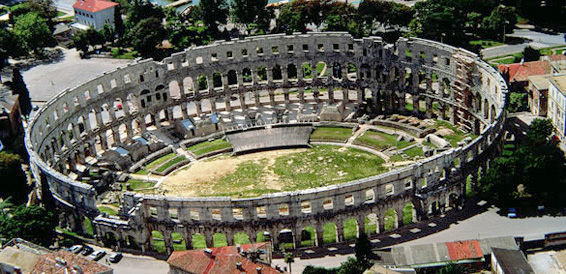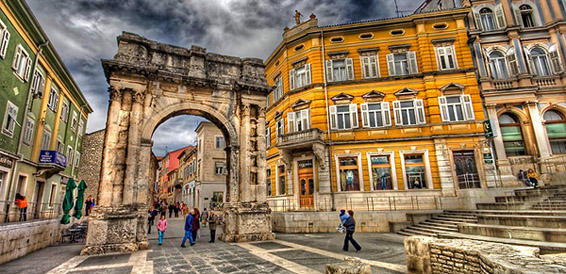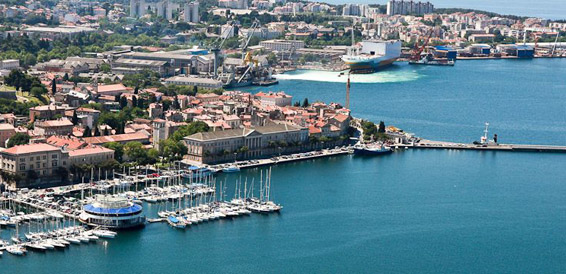
Pula
Pula is the is the largest city of Istria peninsula. Back in the Roman empire times, while under the rule of Julius Caesarus, it had over 30,000 citizens and was an administrative centre of the region. Now, a favorite tourist visiting place, Pula is, historically, an extremely interesting place, holding evidence to even the presence of Homo erectus at 1 million years ago! Pottery findings from the neolithic period suggest human settlements were built on area around Pula many milleniums ago. Archeological evidence suggests the city itself dates back to 10th century BC. Over the time, as rulers changed, each culture present left its mark on the architecture of Pula's buildings, therefore, making it inceribly beautiful and unique.
Mostly known for the Arena, a 1st century amphitheatre, one of the six biggest remaining Roman amphitheatres in the world, Pula holds more fascinating things to see than one would think of at first. Arch of the Sergii, the Gate of Hercules and the temple of Rome and Augustus from the same period witness the rule of the Roman emperor Augustus and the Roman influence on Pula. The following century Porta Gemina - the Twin Gates were build, now one of the few remaining gates of the city.
Resembling the church in Ravenna, around 546, the amazing Byzantine chapel of St. Mary Formosa was build in the form of a Greek cross.
Orthodox Church of St. Nicholas also holds the Ravenna-style polygonal apse and originally dates from the 6th century, but was partially rebuilt in the 10th century. Another amazing historical monument is the Church of St. Francis built as an unique fusion of romanesque style and gothic decorations in 13th and 14th centuries.
  |
The 6th century Cathedral of the Assumption of Blessed Virgin Mary is a true timeline of most of the Pulas past itself. Almost completely rebuilt in the 15th century, following the Genoese and Venetian attacks, it got its present form when a late Renaissance façade was added in the early 16th century. Windows of the aisles underwent reconstruction in Gothic style after a fire in 1242, and the belfry in front the church was built between 1671 and 1707 with stones form the Arena.
On top of the central hill, in the old city, lies an ancient star shaped castle with four bastions. Built by the Venetians in the 14th century on the remains of the Roman capitolium, it was designed by French military architect Antoine de Ville. Since 1961, it houses the Historical Museum of Istria. Close by, on the north-eastern slopes, one can see the remains of the 2nd century theatre.
Pula is a home to many forts build over the past, to help defending the city from sea and land. One of them, Fort Bourguignon was built by Austrian empire to protect the port from the navy. Pula Aquarium, the biggest aquarium in Croatia is located in the Austro-Hungarian fortress Verudela, which was built in 1886. Fortress is being transformed into the aquarium since 2002. The installation consists of about 60 tanks on the ground floor, a moat, and a first floor of the fortress. In the approximately 2000 m2 area, visitors can see all the fish inhabiting the Adriatic Sea, tropical fish, freshwater fish and some representatives of European rivers and lakes.
Pula's lively history can also be seen through cheerful locals, mainly engaged in fishing and tourism, who are commonly fluent in foreign languages, specially Italian, German and English.